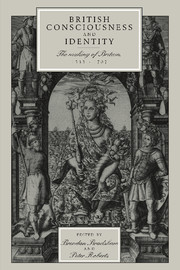Book contents
- Frontmatter
- Contents
- Notes on the contributors
- Preface
- Introduction
- 1 Tudor Wales, national identity and the British inheritance
- 2 The English Reformation and identity formation in Ireland and Wales
- 3 Faith, culture and sovereignty: Irish nationality and its development, 1558–1625
- 4 From English to British literature: John Lyly's Euphues and Edmund Spenser's The Faerie Queen
- 5 The British problem in three tracts on Ireland by Spenser, Bacon and Milton
- 6 James Ussher and the creation of an Irish protestant identity
- 7 Seventeenth-century Wales: definition and identity
- 8 Scottish identity in the seventeenth century
- 9 The Gaidhealtachd and the emergence of the Scottish Highlands
- 10 ‘No remedy more proper’: Anglo-Irish unionism before 1707
- 11 Protestantism, constitutionalism and British identity under the later Stuarts
- Index
11 - Protestantism, constitutionalism and British identity under the later Stuarts
Published online by Cambridge University Press: 15 March 2010
- Frontmatter
- Contents
- Notes on the contributors
- Preface
- Introduction
- 1 Tudor Wales, national identity and the British inheritance
- 2 The English Reformation and identity formation in Ireland and Wales
- 3 Faith, culture and sovereignty: Irish nationality and its development, 1558–1625
- 4 From English to British literature: John Lyly's Euphues and Edmund Spenser's The Faerie Queen
- 5 The British problem in three tracts on Ireland by Spenser, Bacon and Milton
- 6 James Ussher and the creation of an Irish protestant identity
- 7 Seventeenth-century Wales: definition and identity
- 8 Scottish identity in the seventeenth century
- 9 The Gaidhealtachd and the emergence of the Scottish Highlands
- 10 ‘No remedy more proper’: Anglo-Irish unionism before 1707
- 11 Protestantism, constitutionalism and British identity under the later Stuarts
- Index
Summary
Throughout the later Stuart period the nations of the British Isles became increasingly aware that their political, economic and religious interests were interdependent. The British wars of religion of 1639 to 1651, the union of England, Scotland and Ireland under the Commonwealth, the anti-Jacobite wars in Scotland and Ireland which followed and secured the Glorious Revolution in England, and the union of the English and Scottish kingdoms of 1707, ensured that the subjects of the seventeenth-century Stuart multiple monarchy became conscious of their dependence on the workings of a ‘British’ three-kingdom system. However, it will be argued here that the sense that the Stuarts' British dominions comprised more than a dynastic ensemble was not reflected in the emergence of a common British identity during this period. First, the existing national traditions of England, Scotland and Ireland proved too resilient to be easily fused beneath an overarching pan-Britannic identity. Moreover, it will be suggested, these identities found expression in three incompatible discourses. The conflicting regnal claims and counter-claims which constituted the principal expression of English, Scottish and Irish national identities were exacerbated by the politics of the composite state. For instance, in the century after the union of the crowns, Scottish churchmen, Episcopalians as well as presbyterians, were particularly prone to fears of Anglican ecclesiastical imperialism. Such jurisdictional anxieties added to the more obvious confessional divisions which plagued British protestantism.
It will be clear from the analysis that follows, therefore, that no plausible British identity capable of engaging the affections of the various British peoples emerged under the Stuart dynasty.
- Type
- Chapter
- Information
- British Consciousness and IdentityThe Making of Britain, 1533–1707, pp. 321 - 342Publisher: Cambridge University PressPrint publication year: 1998
- 3
- Cited by



